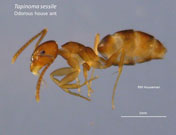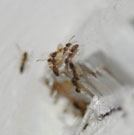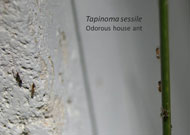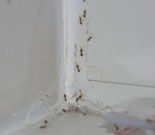home | fall garden | japanese maple garden
Odorous House Ant
The odorous house ant also known as the "coconut ant" gets its common names from the odor ants produce when crushed, which is similar to the pungent odor of a coconut. Ants are social insects, which mean they live in large colonies or groups. Depending on the species, ant colonies can consist of millions of ants. There are over 12,000 species of ants world-wide and 450 species in North America. The odorous house ant is native to the United States and ranges in color from brown to black. They are quite small ranging in size from 1/16th to 1/8th of an inch. The odorous house ant is a scavenger/predator ant that will eat most household foods, especially those that contain sugar. Indoors they will colonize near heat sources or insulation. Outdoors they tend to colonize under rocks and exposed soil. Colonies of the odorous house ant range in size from 100 to 10,000, and house several queens. A colony of ants contain three different ants with specific duties; queen, worker, and soldier. The queen lays the eggs while the workers and soldiers take care of the eggs and larvae, build and defend the nest and locate food to maintain the colony. Males only appear for a brief time each year and function only in mating. Ant larvae are legless, grub-like and helpless. They must be fed, cleaned and moved around by the adult workers. Larvae play an important role because they are the only ones who can consume solid food particles. When solid food comes into the nest the larvae eat it and regurgitate it into a liquid form for the queen and worker ants. The odorous house ant is the most common home-infesting ant species in Missouri. To prevent them from coming into your home, you must eliminate standing water and look around your foundation for cracks and holes through which they can access your house. Ants have colonized almost every land mass on Earth. Their success in so many environments has been attributed to their social organization and their ability to modify habitats, tap resources, and defend themselves.
 |
 |
 |
 |
